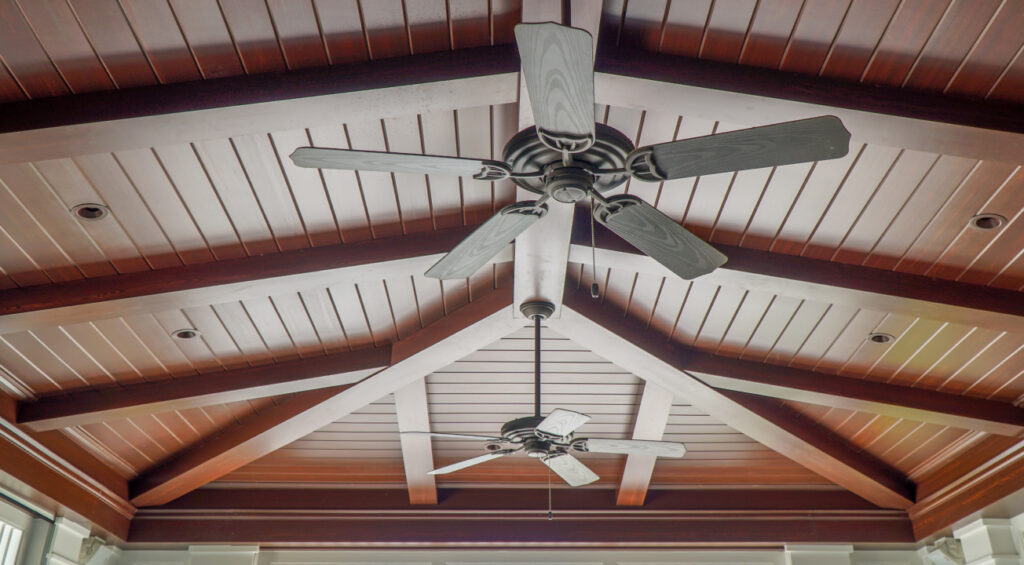Though they’re more commonly associated with exterior construction, soffits have found their way indoors and now provide a unique opportunity to transform your interior design!
Still, with seemingly endless ways to utilize these architectural features, what’s the best way to design them to elevate your spaces?
Are you trying to create a cozy, open space in your living room, or are you just trying to conceal a few eyesores? Either way, we’ll be breaking down all you need to know about soffit interiors within this article, as well as providing some inspiration to help you unleash your creativity.
What is a Soffit Interior?
In essence, a soffit is a surface that’s exposed beneath a roof overhang, arch, or even a staircase. Inside the house, though, soffit interiors are large boxes or shelves that fit between your interior walls and underneath the roof for structural support.
Generally speaking, they’re used to create lower ceilings or as decorative elements that extend downwards from the original ceiling level.
So, there’s both an artistic and functional purpose to installing an interior soffit, whether that’s manipulating how the space looks or simply hiding utilities.
Let’s take a closer look at some of their use cases and why you might want to install one in your house.
Purpose
- Improving Spatial Definition: Soffit interiors subtly define various areas within a larger space, like a dining room or bedroom, making them perfect for open-concept layouts.
- Concealing Services: They can be used to hide wiring, plumbing, and HVAC elements so the overall aesthetics of your room can be maintained while still serving practical needs.
- Architectural Interest: Soffit interiors are often used to add depth and contrast to a space, transforming a plain room into something more dynamic.
Benefits
- Design Versatility: From modern rooms to something more classic, soffit interiors can adapt to various design themes to enhance the overall style of a space.
- Efficient Lighting: Recessed lighting features can be nestled quite discretely within soffits, so this kind of ambient lighting is perfect for elevating the atmosphere or mood within a room.
- Acoustic Control: Because they act as sound absorbers, soffit interiors are a great option if you want to install speakers in a room with high ceilings.
How to Design Your Interior Soffit: 5 Tips
Let’s explore a few of the most impactful ways you can implement soffit interiors in your home.
1. Use Strategic Soffits To Divide Your Rooms Effectively
If you’re trying to divide an otherwise large space into distinct areas, soffit interiors are a smart solution. You could use a lowered soffit to subtly separate your kitchen from the dining area, for instance, so that your rooms remain organized without a need for a wall in between them.
This way, you’re also able to ensure each room maintains its individual identity while still keeping a seamless flow between them.
2. Create a Hidden Space by Adding an Interior Soffit Detail
Interior soffits also give an excellent opportunity for you to create little storage spaces, whether that’s for books, electronics, or even a mini-bar.
If you have either a hinged or sliding mechanism attached, too, this space can be completely hidden so your interior still has a fairly sleek appearance
3. Enhance Your Acoustics Using an Interior Soffit
As mentioned earlier, soffit interiors play a huge role in improving acoustic quality in areas where echoing or sound distortion is an issue. So, installing a soffit that has some kind of sound-absorbing materials isn’t a bad idea if you have a music room or an open office in your house.
4. Vary the Materials You Use
Aside from their functional uses, soffit interiors are also a perfect chance to experiment with aesthetics by using a few different materials and textures.
For example, using metal, dark wood, or even glass can do wonders for giving a room some depth and variety since there’ll be a contrast between the soffit material and the surrounding surfaces.
5. Enhance Coziness by Utilizing an Interior Soffit to Maximize Space
Particularly in reading nooks or anywhere else with plenty of furniture, lowering the ceiling height adds a cozy touch that you might find is missing in rooms with high ceilings.
If you’ve chosen quite light or warm colors, you can improve the snug ambiance of a room even more, making it inviting to sit in for long periods of time.
4 Ideas for Choosing the Best Soffit Interior
Installing a soffit interior isn’t something you’d do on a whim—meticulous planning is crucial here.
1. Plan the Renovation
Before you embark on this project, ensure you’ve clearly outlined your goals for the space—whether that’s defining certain areas, concealing utilities, or generally just enhancing aesthetics.
Ask yourself how the soffit is going to interact with the existing design elements of this room, and how it will impact the overall atmosphere, too.
2. Check the Blueprint
It’s vital to consider the current structural layout of the room you’re installing your soffit interior in—identifying load-bearing walls, electrical wiring paths, and even plumbing configurations, for instance.
The goal here is, naturally, to avoid compromising the integrity of the building, so you should always choose a design that aligns with the existing framework.
3. Decide the Size
Generally speaking, the size of the soffit interior you’re installing is highly relevant for properly achieving the aesthetic and functional goals you’re going for. Larger soffits provide more space for integrated lighting or heightened architectural interest, for example, but more modest sizes tend to focus on concealing utilities like pipes or wires.
4. Check Building Codes
Adhering to local building codes is typically non-negotiable, unfortunately. Different regions of the country might have certain regulations regarding ceiling height, structural modifications, or even fire safety rules that can be a blow to your soffit interior design. Before finalizing your plans, ensure that your design complies with these codes to avoid any legal or safety issues down the line.
Final Thoughts
In conclusion, it becomes clear that while fairly unassuming at the surface level, these architectural elements genuinely hold the power to elevate your living spaces—whether it’s making a bedroom more intimate and cozy or covering up unattractive utilities in your kitchen.
If you’d like further inspiration and expert guidance on how to seamlessly incorporate soffit interiors into your home, consider exploring our portfolio!
From interior design to architectural enhancements, our team can provide you with all the expertise needed to create captivating and functional spaces throughout your house.













